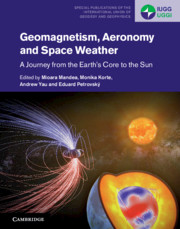Book contents
- Geomagnetism, Aeronomy and Space Weather
- Special Publications of the International Union of Geodesy and Geophysics Series
- Geomagnetism, Aeronomy and Space Weather
- Copyright page
- Contents
- Contributors
- Preface
- Part I Introduction
- 1 Objectives of Geomagnetic and Aeronomy Studies
- 2 Why Study the Geomagnetic Field?
- 3 Major Scientific Contributions of the International Association of Geomagnetism and Aeronomy (IAGA) during the Past 100 Years
- Part II Geomagnetic Field
- Part III Spatial and Temporal Variations of the Geomagnetic Field
- Part IV Space Weather
- Part V Magnetic Fields beyond the Earth and beyond Today
- Index
- References
2 - Why Study the Geomagnetic Field?
from Part I - Introduction
Published online by Cambridge University Press: 25 October 2019
- Geomagnetism, Aeronomy and Space Weather
- Special Publications of the International Union of Geodesy and Geophysics Series
- Geomagnetism, Aeronomy and Space Weather
- Copyright page
- Contents
- Contributors
- Preface
- Part I Introduction
- 1 Objectives of Geomagnetic and Aeronomy Studies
- 2 Why Study the Geomagnetic Field?
- 3 Major Scientific Contributions of the International Association of Geomagnetism and Aeronomy (IAGA) during the Past 100 Years
- Part II Geomagnetic Field
- Part III Spatial and Temporal Variations of the Geomagnetic Field
- Part IV Space Weather
- Part V Magnetic Fields beyond the Earth and beyond Today
- Index
- References
Summary
In this chapter we provide an introduction to different fields of geomagnetism studies rather than to this book as a whole. The aim is to present the wide, temporaly variable and spatialy heterogeneous subjects covered by geomagnetism studies. Individual parts of this chapter address subjects extending from geodynamo through historical records of the geomagnetic field, its present dynamics, its interaction with solar wind and coronal mass ejections, its influence on the electrodynamics of plasma in near-Earth space,hazards of space weather, and finally to the importance of the geomagnetic field for the biosphere. Individual parts, written by top experts in these fields, are different in both style and length; and in view of the vast range of topics covered, some of the subjects introduced here are not presented in greater details in the whole volume. We believe that this chapter shows the many facets of the role of the geomagnetic field and associated physical phenomena, taking place in our natural environment, some of which may have significant effects on human lives and the technology that we use today. The chapter demonstrates the attractiveness and usefulness of geomagnetism and aeronomy studies in a form suitable for both experts and non-specialists.
Keywords
- Type
- Chapter
- Information
- Geomagnetism, Aeronomy and Space WeatherA Journey from the Earth's Core to the Sun, pp. 7 - 29Publisher: Cambridge University PressPrint publication year: 2019



